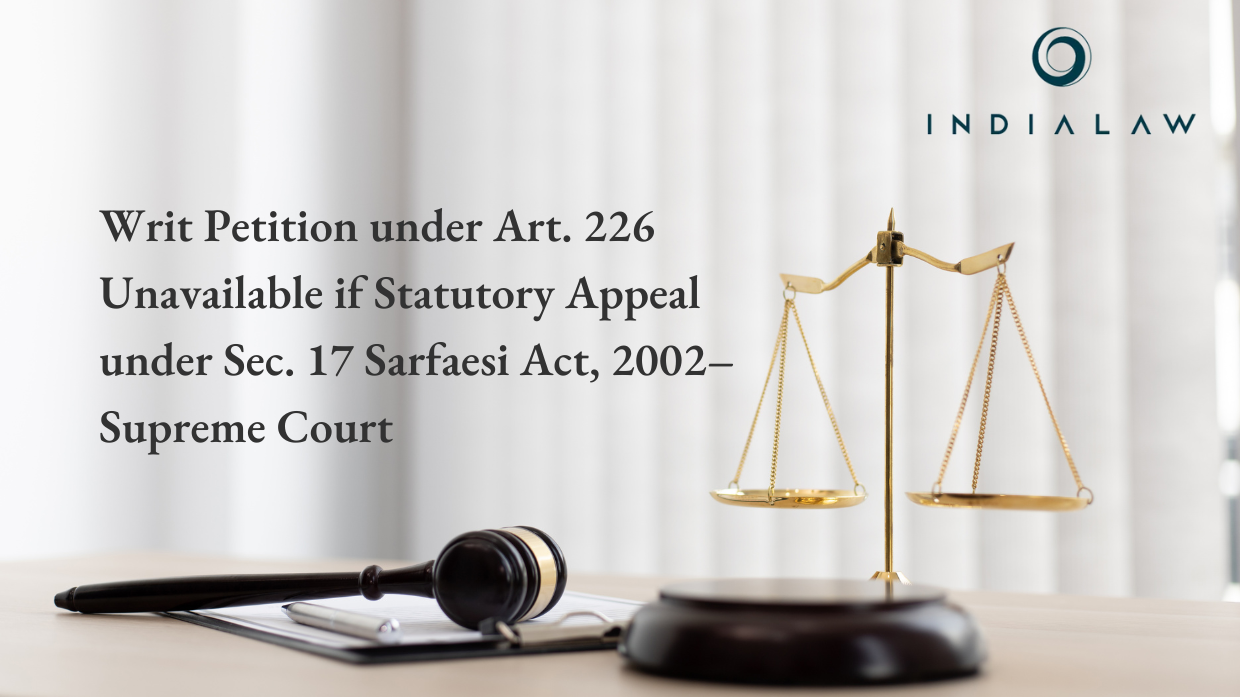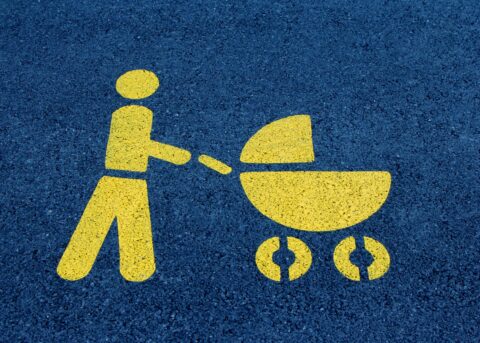Writ Petition Under Article 226 Cannot Be Entertained When Alternative Statutory Remedy Is Available By Way Of Appeal Under Section 17 Of The Sarfaesi Act, 2002–Supreme Court

The Hon’ble Division Bench of Supreme Court comprising of Justice M.R. Shah and CT Ravikumar in G Vikram Kumar V State Bank of Hyderabad & Ors. vide order dated 02.05.2023[i] held that for any action taken by the Bank in accordance with Section 13(4) of the SARFAESI Act, the aggrieved party has recourse through an appeal under Section 17 of the SARFAESI Act to approach the DRT.
FACTS OF THE CASE
The Respondent No. 3 (builder/borrower) had taken a loan from Respondent No. 2 (Bank) for the development of a multistorey housing project. The Respondent No. 3 failed to repay the security interest to the Bank. The Bank initiated proceedings under Section 13 of the SARFAESI Act, 2002 and accordingly, the properties of the borrower were attached under Section 13(4) of the SARFAESI Act. The borrower filed a Securitization Application before DRT, Hyderabad wherein, the borrower was given the liberty to file a list of prospective buyers of the flats/ property to enable the Tribunal to consider the same for the repayment of the Bank’s dues.
The Respondent no. 1 (Third party) and the Borrower entered into a Memorandum of Understanding for the sale of Flat no. 6401, stating that they shall obtain clearance to process the agreement to sale. However, the said agreement was executed without informing or obtaining any consent from DRT or the Bank.
The Bank issued a public e-auction notice regarding the properties of the Borrower on 28.07.2016. Flat no. 6401 was also subjected to the auction. The Borrower approached DRT praying for a stay on all proceedings of the Bank pursuant to the auction notice. The DRT rejected the Application stating that the Applicant entered into an agreement with a third party without the permission of the Respondent Bank or Tribunal and declared such a transaction void. Thereafter e-auction was conducted by the Bank on 31.08.2016 and the Appellant was declared as a successful bidder with respect to Flat No.6401.
The Respondent No. 1(Third party) filed a Writ Petition before the High Court challenging the e-auction Notice concerning Flat No. 6401. However, the fact that the auction was already conducted was suppressed. The High Court stayed the auction of Flat No. 6401 as notified under the e-auction sale notice subject to Respondent No. 1 paying the Bank an amount not less than 25.81 lakhs before the scheduled date and time of the auction, failing which, the Bank shall be free to proceed with the auction.
The Appellant (the successful auction purchaser) filed an application for getting impleaded in the said Writ Petition and filed a Counter Affidavit stating that the Respondent No. 1 had not informed the Court that the auction was already conducted when the stay order was passed. The Bank also filed a Counter Affidavit seeking the dismissal of the Writ Petition primarily on the ground that an alternative remedy was available under Section 17 of SARFAESI Act. Despite the above, the High Court allowed the said Writ Petition filed by Respondent No. 1.
Consequently, upon rejection of the review application filed against the final decision of the High Court allowing the main Writ Petition, the Appellant filed the present appeals before the Hon’ble Apex Court.
CONTENTIONS OF THE PARTIES
The Learned Senior Advocate for the Appellant contended that Respondent No. 1 had concealed material facts, which were particularly highlighted by the Appellant in the counter affidavit. The Appellant had pointed out that at the time of filing the writ petition and obtaining interim relief, the auction had already taken place, wherein the Appellant emerged as the successful bidder.
The Learned counsel appearing for Respondent No. 1 submitted that Section 13(8) of the SARFAESI Act shall be applicable in the said case. Therefore, when Respondent no.1 being the agreement to the sale holder of the flat in question agreed to pay/deposit the entire sale consideration, the High Court did not error in considering the Writ Petition under Article 226 of the Constitution of India challenging the e-auction notice.
FINDINGS OF THE SUPREME COURT:
The Supreme Court observed that the aggrieved party has a remedy available by way of appeal under Section 17 of the SARFAESI Act to approach the DRT against any steps taken by the Bank under Section 13(4) of the SARFAESI Act. Therefore, in light of the alternative statutory remedy available by way of Appeal under Section 17 of the SARFAESI Act, 2002, the High Court should not have entertained the Writ Petition under Article 226 of the Constitution of India wherein the e-auction notice was challenged.
The High Court has committed a grave error by considering the Writ Petition under Article 226 of the Constitution of India, which challenges the e-auction notice issued by the Bank in the exercise of power under Section 13(4) of the SARFAESI Act.
The Hon’ble Supreme Court opined that it is quite debatable whether Section 13(8) of the SARFAESI Act shall be applicable in favour of a person who is only an agreement to the sale holder or only in case of the borrower who is ready and willing to pay the entire debt.
In the current case, the borrower was unsuccessful to get any relief from the DRT. The borrower did not apply and/or invoke Section 13(8) and did not agree to clear the entire dues. Hence, the High Court has materially erred in allowing the Writ Petition.
The Supreme Court proceeded to quash and set aside the impugned Judgement and order passed by the High Court. The Bench further directed full payment of the auction sale consideration by the Appellant (after deducting the 25% of the amount already deposited earlier) with 9% interest from the date of auction till the actual amount is paid and the sale certificate be issued in favour of the Appellant with respect to Flat No. 6401.
Accordingly, the present Appeals were allowed.
[i]Civil Appeal Nos. 3152-3153 of 2023
By entering the email address you agree to our Privacy Policy.



